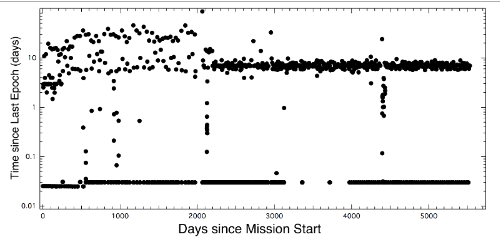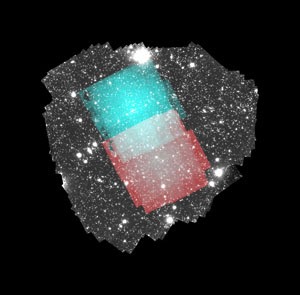The field is observed with the IRAC mid-infrared instrument on Spitzer as part of the routine calibration suite. Every set of 100-second frametime calibration observations have been reduced and coadded. There are 1011 epochs at 3.6 and 4.5µm spanning 2003-2019 (the entirety of the Spitzer mission), while 295 epochs spanning 2003-2009 exist for 5.8 and 8.0µm (the Spitzer cryogenic mission).
However, the cadence is non-uniform as is the pointing. Early in the mission, these observations occurred at every instrument turn-on and turn-off (the three Spitzer instruments being turned on and off in roughly two week instrument campaigns), as well as every three days. After several years this was scaled back to just the instrument power events. In the warm mission (after the cryogen ran out in year 5), the instrument was left permanently on. As a result, the calibration suite was simply executed roughly every week. However, without cryogen the two long wavelength detectors (5.8 and 8µm) no longer functioned, so only 3.6 and 4.5µm data are available for 2/3 of the mission lifetime.
As shown in the figure below, the epochal cadence is typically of order an hour (the gap between the 100-second normal and HDR calibration datasets), with a second cadence of seven days (the separation between full calibration suites). The exact cadence varies due to variations in the IRAC calibration strategy made to accommodate science observation scheduling.
However, the cadence is non-uniform as is the pointing. Early in the mission, these observations occurred at every instrument turn-on and turn-off (the three Spitzer instruments being turned on and off in roughly two week instrument campaigns), as well as every three days. After several years this was scaled back to just the instrument power events. In the warm mission (after the cryogen ran out in year 5), the instrument was left permanently on. As a result, the calibration suite was simply executed roughly every week. However, without cryogen the two long wavelength detectors (5.8 and 8µm) no longer functioned, so only 3.6 and 4.5µm data are available for 2/3 of the mission lifetime.
As shown in the figure below, the epochal cadence is typically of order an hour (the gap between the 100-second normal and HDR calibration datasets), with a second cadence of seven days (the separation between full calibration suites). The exact cadence varies due to variations in the IRAC calibration strategy made to accommodate science observation scheduling.


As the spacecraft orbits the sun with an orbital period of roughly one year, the rotation angle of the instrument rotates with respect to the sky at the rate of roughly one degree per day. As a result, the relative location of the two FOVs is constantly changing. In effect, they rotate around the point between them, which is tied roughly to the center of the Dark Field. Slight adjustments are made during the scheduling process in order to avoid several bright stars that lie near the edge of the field. The combination of field rotation and the separate fields of view mean that for most sources the time series will have multi-month gaps corresponding to those times when the target could not be observed due to an unfavorable spacecraft roll angle.
This link is a movie of the actual 3.6µm data as it is taken over the course of the mission, illustrating the observation pattern.
This link is a movie of the actual 3.6µm data as it is taken over the course of the mission, illustrating the observation pattern.